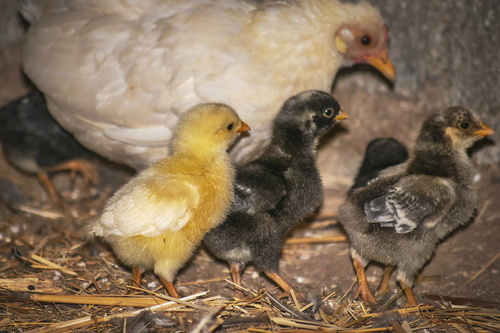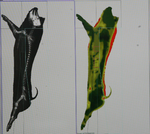
GONDRET Florence
- PEGASE, INRA, Saint Gilles, France
- Molecular biology, Monogastrics, Physiology
- recommender, manager
Recommendations: 3
Reviews: 0
Recommendations: 3

On-farm hatching and contact with adult hen post hatch induce sex-dependent effects on performance, health and robustness in broiler chickens
The hen, the egg and the chick in conventional and on-farm hatching systems
Recommended by Florence Gondret based on reviews by Nicolas Bedere and Anna OlssonTo limit the use of antibiotics in the few days after hatching, it is necessary to improve the robustness of chicks during the early post-hatch period. This can be achieved by ensuring immediate access to feeds, optimizing the implantation and maturation of the microbiota and immune system of each chick, and minimizing exposure of stressors such as transportation. The study conducted by Guilloteau and colleagues (2024) compared the performance and health of chicks raised in conventional hatching systems with those raised in on-farm hatching systems. The authors showed that both systems yielded similar hatching percentage of eggs. Chicks from on-farm hatching systems exhibited higher body weights during the post-hatch period compared to those from conventional hatching, whereas health parameters were not affected by the system. An originality of the study was the examination of the benefits of the presence of an adult hen in hatching systems. The effects on chick traits were interpreted in relation to the hen behavior at hatching and a classification according to maternal or agonistic activities towards the chicks. However, the experimental design did not allow to make statistical correlations between hen behavior pattern and chick traits. Importantly, the presence of a hen decreased the hatching percentage, and this was likely associated with hen aggressiveness in the pen. The presence of the hen deteriorated the quality scores of the chicks in the on-farm hatching system, and increased mortality of chicks at hatching, negatively impacting chick weight gain and feed efficiency during the few days after hatching in both conventional and on-farm hatching systems. Thereafter, the effect of the presence of a hen on chick body weight was different according to the sex of the chicks and the type of hatching system. The presence of a hen did not reduce the parasitic load of the chicks nor improved clinical signs. No specific characterization of the fecal microbiota of the chicks was conducted, preventing the testing whether or not the presence of the hen affected the early implantation and maturation of the chick microbiome. Altogether, the data indicate that on-farm hatching systems are at least equivalent (in terms of health traits, feed efficiency) or even favorable (for faster growth in the early period after hatching) for chicks. Training the hens (considered as foster adults) to the presence of eggs and chicks or selecting hens according to specific activity behavioral patterns could be ways to establish better interactions between hens and chicks. Although the number and type of environmental stressors tested in the experiment differ from those in commercial farms, the article opens new perspectives for alternative hatching and farming practices.
Reference
Guilloteau LA, Bertin A, Crochet S, Bagnard C, Hondelatte A, Ravon L, Schouler C, Germain K, Collin A (2024) On-farm hatching and contact with adult hen post hatch induce sex-dependent effects on performance, health and robustness in broiler chickens. bioRxiv, 2023.05.17.541117. ver. 3 peer-reviewed and recommended by Peer Community in Animal Science. https://doi.org/10.1101/2023.05.17.541117.

Decreasing the level of hemicelluloses in sow's lactation diet affects the milk composition and post-weaning performance of low birthweight piglets.
Varying the hemicellulose content in the diet of lactating sows highlights the importance of early-life interventions for improving health and performance of small piglets during the post-weaning period
Recommended by Florence Gondret based on reviews by Hélène Quesnel and Myriam GrundyOne of the key questions in pig industry nowadays is how health and performance of piglets can be improved by sow nutrition and milk composition. The levels of dietary fibers in sow’s gestation diet have positive effects observed on the litters. However, the composition of dietary fibers and the organization of polysaccharides within the cell wall in the different plants determine their physicochemical properties and, thereby, their behaviour in the gut of the sows and the subsequent physiological response of the animals. Hemicelluloses are polysaccharides constituents of the cell walls of plants, which are fermented in the gut to produce volatile fatty acids (VFA). These VFA can serve as energy source for milk synthesis and can thereby influence the development of suckling piglets. Palumbo and colleagues (1) proposed an original experimental design to compare diets with similar fiber contents but different hemicellulose levels, thanks to varying the sources of fibers used in the dietary formulations. Effects were studied on performance and health of lactating sows and their piglets during suckling period and until post-weaning. The dietary treatments had no effect on the total number of piglets weaned and, consequently, on litter weight at weaning. Milk yield was not influenced by the dietary treatments, but milk composition (lactose content, copper and threonine proportions) was affected by the level of hemicellulose in the maternal diets. With a decreasing hemicellulose level in sow diet, milk lactose content linearly decreased, whereas the copper and threonine contents linearly increased. There was no effect on piglet performance during the lactation period. During the second week of post-weaning, a quadratic increase in the incidence of diarrhoea and the number of days with diarrhoea for suckling piglets was observed with decreasing hemicellulose level in diet. Interestingly, the observed effects were partly different for piglets born with a low body weight. Indeed, there was a linear decrease in the incidence of diarrhoea and days with diarrhoea with decreased hemicellulose level in the maternal diet for those piglets, together with increased growth performance from birth to two weeks post-weaning. The authors postulated that the improved growth performance and the lower incidence of diarrhoea observed in small piglets during post-weaning period may be related to the increased abundance of threonine and copper and increased concentration of total VFA in milk of sows fed a diet with reduced hemicellulose levels. This study confirms the importance of early-life interventions to improve the post-weaning development and health of this sub-population of piglets.
Reference
(1) Palumbo F, Bee G, Trevisi P, and Girard M. (2022). Decreasing the level of hemicelluloses in sow's lactation diet affects the milk composition and post-weaning performance of low birthweight piglets. agriRxiv 2022.00116, ver 4 (R3), peer-reviewed and recommended by PCI Animal Science. https://doi.org/10.31220/agriRxiv.2022.00116

Accuracy of predicting chemical body composition of growing pigs using dual-energy X-ray absorptiometry
Accurate predictions of chemical composition of pigs for a wide range of body weights: no longer a myth!
Recommended by Florence Gondret based on reviews by Mathieu Monziols and 1 anonymous reviewerAssessing body or carcass composition in growing pigs is essential to refine nutritional models, select for specific traits and evaluate pork products. The gold standard methods are dissection and chemical measurements, which are time-consuming and invasive ways to obtain the data. Different teams have tested dual-energy x-ray absorptiometry (DEXA), especially for determining total and regional body composition of fat, soft lean tissues and bone minerals [1-3]. The DEXA measurements are quick, non-invasive, precise, and operator independent. However, the instruments from different manufacturers are unique in implementation so that it is difficult to obtain and share generalized equations. In addition, the validity and accuracy of the measures when applied to pigs having very different composition have been scarcely addressed.
The present manuscript shows that carcass analysis by DEXA can be used to predict empty body chemical composition, and it provides accuracy values for the content in single nutrients (protein, lipids, Ca, P). The body weight range used to generate differences in body composition is very large (20 to 100 kg), which is important when studying pigs along growth. Moreover, regression equations within weight classes (20, 60 and 100 kg) show no important biases, with the exception for body fat especially at the earliest growth stages. Limitations of the technique are the needs of anesthesia when applied to living pigs, and of standardizing the positions of body, carcass and cuts when applied to living or dissected pigs. Another originality of the manuscript is the comparison of the obtained calibrations with previously published prediction models, showing that the differences do not preclude the possibility to use a single model when built from a meta-analysis of the different data. Taken together, this work offers good perspectives to refine nutritional models by inputs from rapidly analyzed body chemical composition and to monitor body and carcass composition in several pigs for genetics applications.
References
[1] Mitchell AD., Scholz AM., Pursel VG., and Evock-Clover CM. (1998). Composition analysis of pork carcasses by dual-energy x-ray absorptiometry. Journal of Animal Science. 76(8), 2104-14. https://doi.org/10.2527/1998.7682104x
[2] Marcoux M., Bernier JF., and Pomar C. (2003). Estimation of Canadian and European lean yields and composition of pig carcasses by dual-energy X-ray absorptiometry. Meat Science. 63(3), 359-65. https://doi.org/10.1016/S0309-1740(02)00094-3
[3] Kipper M., Marcoux M., Andretta I., and Pomar C. (2018). Repeatability and reproducibility of measurements obtained by dual-energy X-ray absorptiometry on pig carcasses. Journal of Animal Science, 96(5), 2027-2037. https://doi.org/10.1093/jas/skx046 "